Symbols
420 YEARS SINCE THE INCINERATION OF RELICS OF ST. SAVA IN VRAČAR
Vozar’s Red Cross
Many threads connected honorable Gligorije Vozarović (1790–1848), famous bookbinder and bookshop owner from Belgrade, with the memory of St. Sava. The initiative to officially proclaim this saint as patron saint of Serbian education and science, which happened in 1840, was started in his bookshop. Seven years later, in the place where, according to the legend, the ashes of the Holy One were scattered, Vozarović placed a votive cross made of red wood. It was visible from afar. An entire part of Belgrade is today called after that red cross. However, it remains unclear whether Gliša Vozarović knew much more about that place than we do
By: Jovan Pejčić
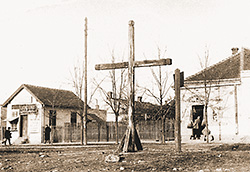 In the 1830s, the founder of the Serbian Orthodox Church and its first archbishop was frequently mentioned in all Serbian lands. In the 1830s, the founder of the Serbian Orthodox Church and its first archbishop was frequently mentioned in all Serbian lands.
Serbian Papers in Budim, in 1837 and 1838, wrote a series of texts about St. Sava. The final text was about the incineration of his relics, mentioning, among others:
”The relics of St. Sava, upon the order of Sinan-Pasha, were moved to Serbian Belgrade in 1594 and incinerated in Vračar…”
Introducing the Day of St. Sava as a general school celebration in the Princedom of Serbia was crucially encouraging to begin the search and finally determine the exact place where the relics of the first Serbian educator were incinerated.
This idea also originated, according to the testimonies of contemporaries, from Gligorije Vozarović.
The attempts of intellectuals, however, did not lead to success soon, to the Ministry of Education also got involved in the search. In November 1844, it addressed metropolitan Petar Jovanović with a single question: does the Church know any details about the place where the relics of St. Sava were incinerated?
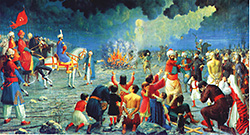 ”Your Eminence knows how the body of the Serbian Enlightener was incinerated in Vračar by the Turks, and it is also known that Serbian people filled with esteem and awe made a fence around the place where the body of the Saint was incinerated, and that the fence was torn down in 1716 in the then war. The Ministry of Education wishes to venerate the memory and have the place, known to the people from legends, remembered. Therefore it finds it convenient to suggest the Land Board fence in the place, raise a cross in it. Therefore Your Eminence is asked to give his opinion about it to the Ministry.” ”Your Eminence knows how the body of the Serbian Enlightener was incinerated in Vračar by the Turks, and it is also known that Serbian people filled with esteem and awe made a fence around the place where the body of the Saint was incinerated, and that the fence was torn down in 1716 in the then war. The Ministry of Education wishes to venerate the memory and have the place, known to the people from legends, remembered. Therefore it finds it convenient to suggest the Land Board fence in the place, raise a cross in it. Therefore Your Eminence is asked to give his opinion about it to the Ministry.”
The metropolitan’s reply was not consoling:
”The fact that the relics of St. Sava, first Archbishop and Serbian Educator, were incinerated in Vračar is familiar to us; however where it was done, we could not understand for certain, although we have asked and spoken with many about it. However, if the reputable Ministry thinks that it will be found, we approach with joy the opinion of the reputable Ministry it has informed us about in the letter from the 16th, to have the place fenced in and marked with a cross.”
Regardless of such a reply, the Ministry continued searching. It can be seen from preserved documents that all administrations in Belgrade and its proximity were ordered to ask around in order to find out any solid proof about the place where the Turks incinerated the body of St. Sava.
This, however, didn’t bring any success.
MARK ON THE VRAČAR MEADOW
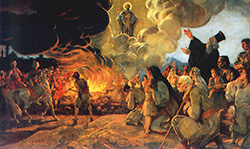 The mark dedicated to St. Sava was raised on the Vračar meadow by patriotic Gligorije Vozarović. In 1847, he bought the field, in which a large wooden cross stood, for 8 golden coins. No one actually knew when exactly the cross was placed there, but Belgradians related it to St. Sava and the blasphemous act of Turkish Sinan-Pasha, leader of the march on rebelled Serbs in Banat. The mark dedicated to St. Sava was raised on the Vračar meadow by patriotic Gligorije Vozarović. In 1847, he bought the field, in which a large wooden cross stood, for 8 golden coins. No one actually knew when exactly the cross was placed there, but Belgradians related it to St. Sava and the blasphemous act of Turkish Sinan-Pasha, leader of the march on rebelled Serbs in Banat.
That old cross or inscription, tells the chronicle writer, at that time, was brought down by a storm, since it was already half-rotten, so Vozarović, in order to preserve the memory of the inscription, placed a new cross.
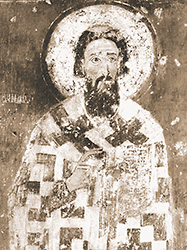 Serbian Newspaper from March 18, 1847, describes Vozarović’s deed to its readers: Serbian Newspaper from March 18, 1847, describes Vozarović’s deed to its readers:
”The famous Serb and honorable citizen of this town, Mr. Gligorije Vozarović, bookbinder and bookshop owner, decorated our landscape with a beautiful sign of his Christian religiousness. Wishing to leave a nice memory in this city area after his death, in the city in which he has spent about thirty years of honorable living, he raised on his own field in Vračar, an elevated place, from which one can see afar, a large cross made of wood, for the passing by Christians. The cross is ornamented with beautifully made icons: icon of Holy Trinity on the side facing the road and icon of St. George, Mr. Gligorije Vozarović’s patron saint. There is a simple inscription under these icons: To God and People – Grigorij Vozarović, 1847. In Vračar. – The cross, together with the holy icons, was consecrated by the local priest, Mr. Panta Mihajlović, on the 12th of the current month, and on the 13th it was raised to the joy and consolation 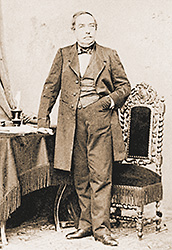 of our faithful Orthodox Serbs…” of our faithful Orthodox Serbs…”
The inscription on the cross was written by Jovan Hadžić.
In the preserved answer to Vozarović’s letter dated January 31, in which ”very generous Gligorije” presents his plan in detail to the ”Serbian patriot” from Novi Sad, expecting from him advice and help, Hadžić, two days later, on February 2, 1847, replies to his ”kind friend”:
”For the inscription you are asking me about, I must notice, if you want the words ‘in Vračar’ and only on one side, in order to avoid wrong talking, it can be written like this: To God and People // Gligorie Vozarović // 1847 // In Vračar.”
It is interesting that the Serbian Newspaper article does not mention a single word about St. Sava. That fact led historians and travelogue writers to new different studies and explanations.
THE CROSS AND LEGENDS
 copy.jpg) In this respect, especially interesting is the writing of priest Steva Dimitrijević: In this respect, especially interesting is the writing of priest Steva Dimitrijević:
”There is a legend that the monks of Mileševa, who followed the body of St. Sava, somehow took away the body by bribing and begging the Turks, and started running with it. Other Turks noticed it, went after them, reached them near present Vozarović’s cross, killed the monks and returned the relics. The legend about it also initiated Gliša Vozarović, bookshop owner from Belgrade, to mark that place with a cross.”
There were, however, researchers who believed Vozarović’s cross can in no way be related to St. Sava and incineration of his relics in Vračar. The entire truth, they believe, lays in what ”Mr. Milan Simić claims, and what he heard from uncle Gliša (Vozarović) himself, that the cross was made for his own memory (thus without any other meaning)”.
Others do not accept such an interpretation. They are convinced that Vozarović’s cross was an act of a considerate and unselfish national and cultural worker.
Svetislav Šumarević best expressed such an opinion:
”Our old Belgradians, sons of Karađorđe’s and Miloš’s heroes, sons of fathers who died for the honorable cross, passionately wanted to raise crosses as memory of victory. Since Belgrade was not completely liberated, due to the Turks who had to live in Belgrade with Serbs for all times, they thought of finding convenient places at least in the free meadows around Belgrade… A place was found quickly. They chose Vračar, where ‘Vračar heroes’ gathered. [...] After finding a place in the vicinity of Belgrade, a man was found to erect the monument. It is a new brother, born in Belgrade, excellent Serb, first bookbinder and bookshop owner in Belgrade, Gligorije Vozarović. [...] He was the first to give an example, so we got ‘Vozarović’s Cross’ 86 years ago, then in the immediate vicinity and now in the center of Belgrade, as the first monument of its kind glorifying our victories.”
TESTAMENTS AND CONTEMPLATIONS
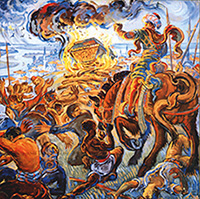 We will not get involved in definite checks here. Both opinions stand as facts impossible to overlook in such a study, as well as impossible to be unconditionally accepted, just like, finally, Vračar and St. Sava could not be separated ever since 1594. We will not get involved in definite checks here. Both opinions stand as facts impossible to overlook in such a study, as well as impossible to be unconditionally accepted, just like, finally, Vračar and St. Sava could not be separated ever since 1594.
The confusion, however, benefits Vozarović. Why a cross? Why after the unsuccessful search for the place where relics of St. Sava were incinerated? Why in Vračar? Why Gligorije Vozarović of all people – for whom we know initiated the mentioned idea?
Not long before that, it happened that Belgradians related the cross in Vračar, ”near Smederevo đeram, in the meadow between Mladonagoričanska and Vojvođanska streets”, to St. Sava, without knowing who and when erected it:
”The cross has been standing here a long time and its erection, which even the oldest neighbors don’t remember, is related to a legend. According to it, in the place where the cross stands, Turks incinerated the body of St. Sava. The memory of this place, therefore, should be visibly marked.”
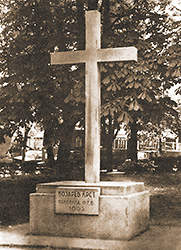 In respect to the cross in Vračar, Vozarović’s widow Sara should be now mentioned in the story. In her testament made on November 13, 1853, Sara left her entire estate to her sister Katarina Zaharijades. The testament, among others, states: In respect to the cross in Vračar, Vozarović’s widow Sara should be now mentioned in the story. In her testament made on November 13, 1853, Sara left her entire estate to her sister Katarina Zaharijades. The testament, among others, states:
”The land in Belgrade, on the trench, where the cross is erected, I leave, following my husband’s recommendation, to the church of Palilula. The church may not sell or dispose this land, it can only collect profits from it. From that profit, it should leave aside a part for making a new cross, same as the one now located on the land.”
Not many people today know that the name ”Crveni Krst” (”Red Cross”) originates from ”Vozarović’s Cross”, made of wood painted in red and decorated with icons.
Such a cross could not resist rain and sun, wind and snow for long, so it had to be restored. Its first restoration was in 1895 and the second in 1923. When, finally, dilapidated in time, Vozarović’s cross fell down, the Society of St. Sava restored it for the third time, with the financial support of the Municipality of Belgrade, but now in red artificial rock.
As a sign of gratitude, an inscription was incised in its foot: Vozar’s Cross.
It was in 1933.
***
In the Center, Above Everything
In the early thirties, the wooden cross still looked grandiose. We have a description from 1931:
”I watch this cross from Vojvođanska Street, with the Banjica hill and fields behind it, and cannot believe that it is almost in the center of the city. More than two meters tall, the top of the cross is decorated with particular notches.”
***
In Red Stone
Lately, many have forgotten Vozarović and the fact that he erected the cross in Vračar.
The cross in red stone can be seen from afar and rises as a landmark of the entire area – who will look at the inscription on the cross?!
”Vozar’s Cross” is thus today known only as Red Cross.
|
